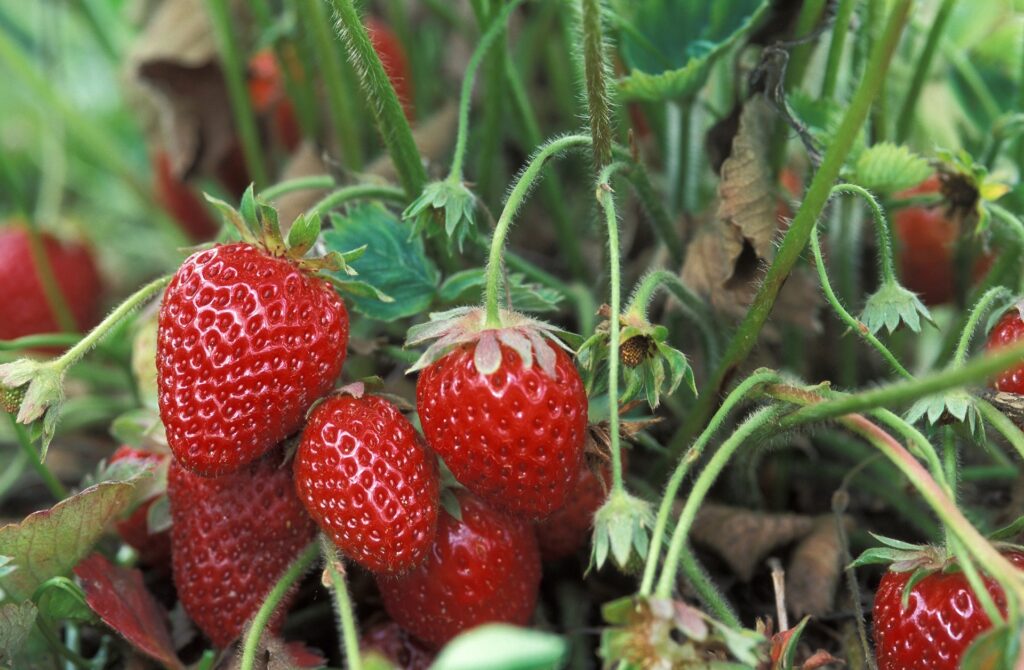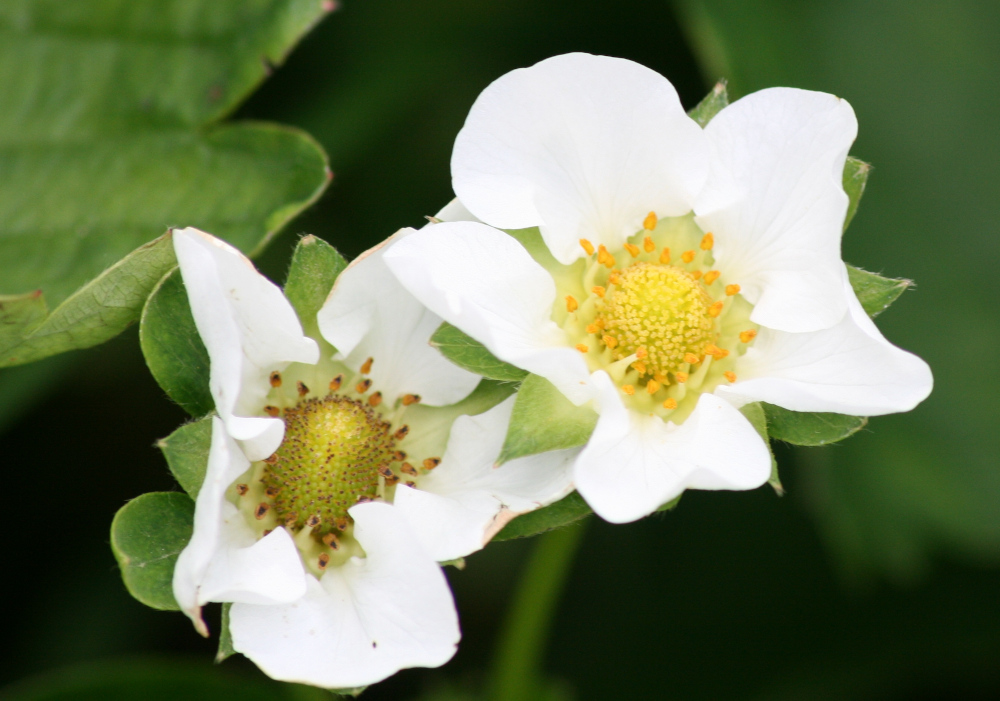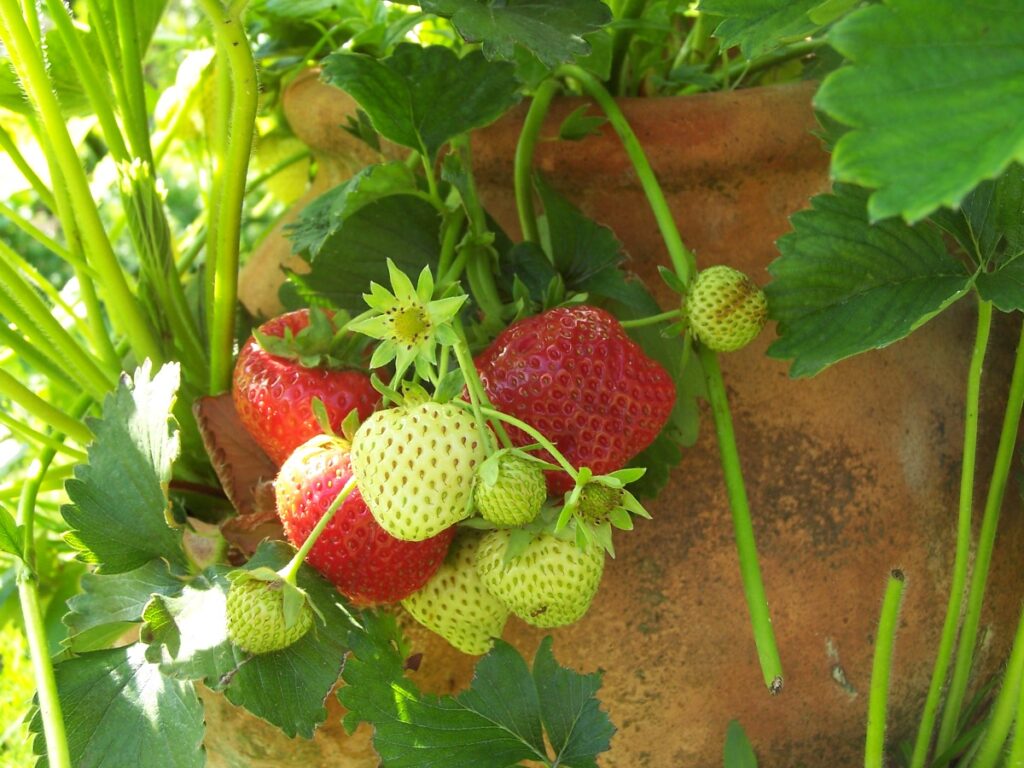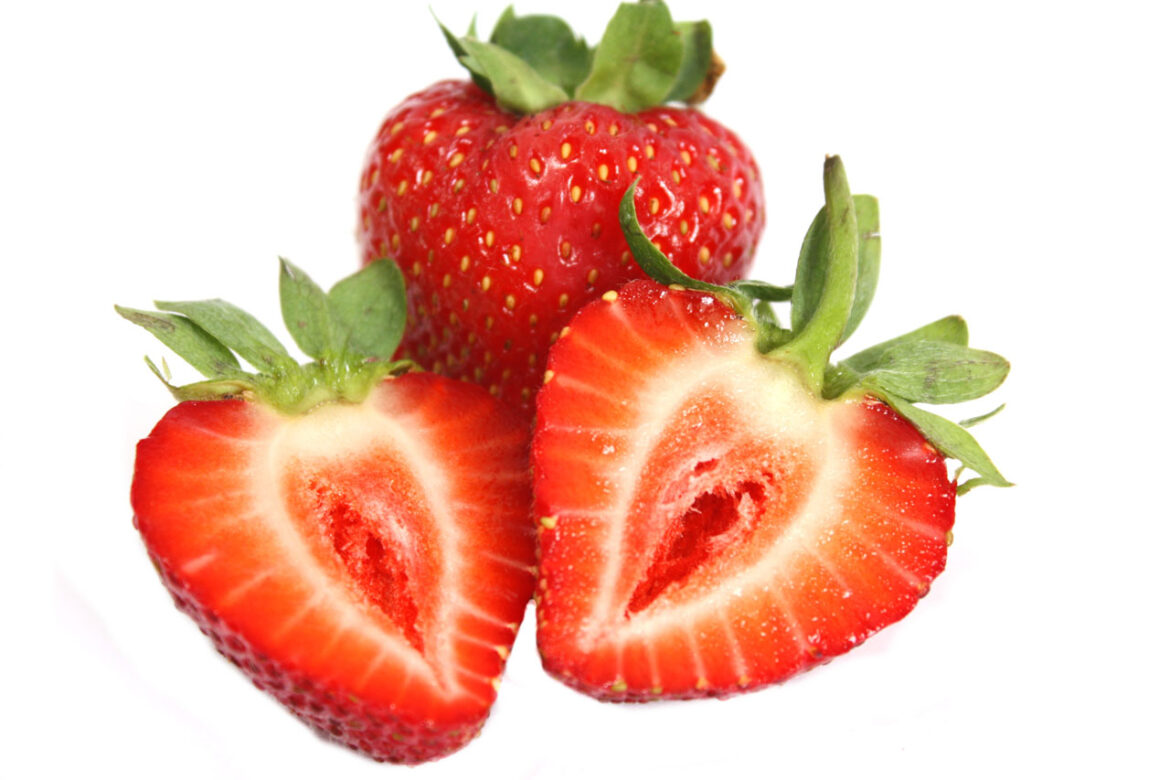Strawberries are a perennial fruit crop that are winter hardy and very easy to grow. Just remember, they should never suffer from a lack of water.
Where to Grow Strawberries
Strawberries are a perennial fruit, winter hardy and easy to grow. They should be planted in late fall or early spring in fertile, well-drained soil in an area that receives full sun. Strawberries have a shallow root system and do not compete well with weeds. Till the strawberry bed in the fall to eliminate pests and plant matter that can cause disease. Plant away from large trees to ensure root systems don’t interfere with your strawberry plants. Healthy plants will produce a quart of strawberries per year. On average, 30 plants will produce enough berries for a family of four.
Recommended Varieties of Strawberries
Types of strawberry Plants:
There are three types of strawberry plants: June Bearing, Ever Bearing, and Day Neutral. June Bearing varieties have one large harvest in late spring over a three week period and generally produce larger fruit and more berries per season than the other types. Ever Bearing varieties have two harvests per season and Day Neutral varieties produce fruit throughout the season. June Bearing varieties are great for canning or freezing, whereas Ever Bearing and Day Neutral varieties are good for snacking on throughout the season. Because Ever Bearing and Day Neutral strawberries produce few runners and have multiple harvests that are exhausting on plants, they should be replaced about every 3 years or whenever they seem to produce less fruit.
Strawberry Varieties
Picking the right variety for your strawberry patch is the first step to growing a successful strawberry crop. Things to consider in picking a variety are hardiness, yield, disease resistance, berry size, flavor, and appearance.
June Bearing Varieties: Allstar, Annapolis, Cabot, Cavendish, Chandler, Clancy, Earliglow, Glooscap, Honeoye, Itasca, Jewel, Kent, L’Amour, Lateglow, Mesabi, Northeastern, Ovation, Surecrop, Sparkle
Day Neutral and Ever Bearing Varieties – Selva, Seascape, Tribute, Tristar, Quinault
| Temperature | |
| Germination | 68 - 72 F |
| For growth | 64 - 77 F |
| Soil and Water | |
| Fertilizer | After harvesting, fertilize with all purpose fertilizer, 1 cup per 10 foot of row. |
| Side-dressing | 3 weeks after plants are set. |
| pH | 5.8 - 6.2 (ideal) |
| Water | Heavy, required frequently during fruiting season. |
| Measurements | |
| Seed Planting Depth | 0" |
| Root Depth | <12" |
| Height | 8 - 12" |
| Width | 9 - 12" |
| Space between plants | |
| In Beds | 12" |
| In Rows | 12" |
| Space Between Rows | 24" |
| Average plants per person | 10 |
| Harvest | |
| Pick when strawberries are bright to dark red, depending on variety. The best fruit is picked early in the morning. | |
| First Seed Starting Date: | 56 - 70 days before last frost date |
| Companions | |
| Companions | Bush beans, spinach, lettuce |
| Incompatibles | Tomatoes, peppers, eggplants, raspberries |
Soil for Planting Strawberries
Strawberries prefer slightly acidic soil with a pH range of 5.5 to 6.5. They grow best in fertile, well-drained, sandy loam soil. The ground should be tilled six inches deep and compost mixed in. Adding compost to your soil will help improve aeration and drainage and improve moisture-holding capacity. Strawberries have a shallow root system and do not compete well with weeds. Till the strawberry bed in the fall to eliminate pests and plant matter that can cause disease.
Planting Strawberries
Germination in 7-37 days. Most strawberries are started from plants; they are much easier to start this way.
When to start seeds:
Start seed indoors 8-10 weeks before the last frost date for your area. Seeds should be frozen for three to four weeks prior to planting to simulate winter and increase the likelihood of germination. Spread ½ to 1” of seed starter mix in a tray and dampen the soil. Sprinkle seeds over the soil and lightly cover with seed starter mix or peat moss so that light can still get through. Cover seeds and place them in direct sunlight, keeping soil moist, uncovering occasionally to allow airflow to plants. Once seeds have germinated, remove the cover. Seedlings are strong enough to be safely transplanted when they have 3 or 4 sets of leaves. Depending on the size of your original planting container, you may need to transplant the seedlings into a larger container before they can be planted outside. Seedlings can be transplanted into raised beds, hanging baskets, or a strawberry pot, depending on your preferences and space limitations. It takes approximately 3.5 to 4 months from the time you plant the seeds until the plant will begin producing berries, although it is often recommended to remove the flowers from the plant the first year to give the plant energy for a larger production the second year, which would not yield any strawberries in the first year. If planting everbearing or day-neutral varieties, flowers should be removed until the official first day of summer, and then allowed to mature into berries.
When to start plants:
Strawberry plants are typically only available when you should plant them in your area, or will be shipped to your area when they should be planted if ordered from a mail-order seed company. When you receive them it is important to plant them right away. If you are unable to plant them right away, store them in a cool location and keep the roots wet, either in a small amount of water or mud. They can be stored in an unheated garage or refrigerator for a short time until you are able to plant them.
It is best to plant strawberry plants outside on a cool, cloudy day and keep plants in a small amount of water in a shady location to protect the roots from exposure to air and direct sunlight. Prune any damaged roots and remove all flowers, runners, and old leaves. Thin long roots to about 5 inches in length. Space plants according to the spacing system you’ve chosen for your strawberry patch (see below). Plant about six inches deep with the crown, or thick part in the center of the plant, just below ground level, half of it buried and half above the soil. Be sure to keep roots spread out in a fan and they should be unexposed. Pack soil around roots to avoid air pockets and secure the plant. A thin coat of mulch, such as clean straw around the bottom of the plant will help keep moisture in and provide a barrier between the plant and the moist soil.

Ripe Strawberries 
Strawberry Blossom 
Strawberries growing
How:
There are several methods to planting strawberries.
Hill System:
This method requires the most work and yields the biggest berries. Set plants 12 inches apart in rows 2 feet apart. All runners are snipped off. You can also plant double or triple rows with 12 inches between each row and 2 feet between double or triple rows and let the runners root. When planting using the hill system, plants must be turned under every two to three years. It is recommended to remove flowers from the plant during the first growing season. The second season will be the best harvest when flowers are removed from the first season. Decreasing in quantity and quality the following year, some growers choose to replant each year.
Matted Row System:
Mother plants are set out two feet apart and all runner plants are allowed to root, resulting in small berries. Although this is the easiest growing system, the quantity and quality of fruits are not the best. The beds formed have about 2-3 inches between plants and a 1 ½ to 2-foot alley between rows should be maintained for plant access.
Spaced Matted Row System:
This is a combination of the hill system and the matted row system. With this system, 4 to 6 runners are allowed to root from each mother plant, forming a circle around the plant. The next year, let all runners root, except any that extend into alleys. Varieties that produce fewer runners are best for this planting method, as it is a lot of work the first year keeping the runners thinned. However, in the second year this system will yield better berry size and quantity than either the matted row or hill system. This method grows bigger berries than any other method, except the hill system.
Three Row Bed System:
With this planting system, plants are set one foot apart with three feet between rows. Two of the earliest runners are allowed to root, one to the left and one to the right. A hairpin can be used to set the runners, keeping them in a straight line until they root. Once they root, they are severed from the mother plant, which is destroyed the following year. Continue to allow enough runners to root in the following years to keep plants a foot apart. This method eliminates the need for replanting.
| Storage Requirements | ||
|---|---|---|
| Refrigerate as soon as possible after picking to maximize shelf life. Wash just before eating or preserving. Cure winter squashes in a dark, humid place for 10 days at 77-86F; then store them at 50-59F in a moderately dry dark place for 5-6 months. Store only the best fruit. Don't allow fruit to touch. Wipe moldy fruit with a vegetable oiled cloth. They can also be frozen or dried. |
||
| Fresh | ||
| Temperature | Humidity | Storage Life |
| 32 - 36F | 90 - 95% | Up to 7 days |
| Preserved | ||
| Method | Taste | Shelf Life |
| Canned | Excellent | 12 months |
| Frozen | Good | 8 - 12 months |
| Dried | Fair | 12 months |
Cultivating Strawberries
In the first season, the strawberries are planted it is important to maintain a weed free strawberry patch. Flowers should be pinched off as soon as they appear to promote early vigorous plant growth and early formation of runner plants. The first crop should be harvested a year from planting. Runners should be positioned so that they develop a density of approximately 5 plants per square foot. As the plants develop, add additional side dressing of about 1 pound of 12-12-12 fertilizer per 50 foot of row. This may be repeated about a month later if necessary. In late August or early September, an additional application of one pound of 12-12-12 per 50 feet of row will be useful in assisting bud formation. Strawberries will benefit from irrigation; they should never suffer from a lack of water. Once the plants are dormant for the winter, apply a 2-inch thick layer of straw or bark mulch. The following spring, the mulch can be raked into the rows.
Harvesting Strawberries
3-4 months. Strawberries are the best (sweetest) when fully ripened on the plant. It’s best to leave them on the plant for a day or two after they turn red. If unsure of ripeness, give them a taste test. Be gentle when harvesting berries, ripe ones bruise very easily. Snap the stem just above the berry to remove them from the plant. Keep harvested berries out of direct sunlight and get them someplace cool, such as a refrigerator as soon as possible after picking to maximize storage time. Strawberries can be eaten fresh or preserved by canning, freezing, or dehydrating.
Strawberry Pests
There are around 200 species of pests known to attack strawberries.
- Aphids – A well-known pest insect that can quickly settle into soft tissue and damage the plant by sucking sap from just below the leaves. Symptoms include clusters of aphids at plants tips or on the undersides of leaves. In severe cases, the plant may begin to wither. Applying soapy water to plants or releasing ladybugs into the garden can help with aphid infestation.
- Birds – A common crop thief that can be easily discouraged by covering the area with cheesecloth, weighted down on the sides to keep it in place
- Crown Borer – Adults are small, brownish-red snouted beetles that feed on foliage and berries. Larvae are little, white, legless grubs that tunnel through the crowns. Short of using chemicals, infected beds must be destroyed. When replanting, keep at least 300 feet away from the original site.
- Cut Worms – Fleshy green to black striped worms. Cardboard collars can be used to keep the worms from getting to the plants. Also, mothballs or blood meal can be spread around the bed. Digging up the ground in early spring will help to expose and kill cutworms.
- Cyclamen Mites – Barely visible white, green or brown mites that feed at the base of plants on leaves and flowers. Spraying the plant forcefully with water, ensuring to spray the undersides of leaves may help to rid this pest.
- Slugs and Snails – Slime trails and irregular holes in fruits are evidence of slugs and/or snails. Use straw as a mulch to serve as a barrier between your plant and the wet soil. Also, you can try putting stale beer in pie plates and setting them in the strawberry patch. Slugs will crawl in and drown.
Strawberry Diseases
Common diseases of strawberry plants include powdery mildew, leaf spot, leaf blight, slime molds, red stele, verticillium wilt, black root rot, nematodes, gray mold, rhizopus rot, and leather rot to name a few.
If your plant is showing symptoms of disease, such as powdery spots or brownish-red spots on leaves, curled leaves, rotten spots on fruits, or decreased yields, remove all infected plant matter as soon as possible, preferably when the plant is dry.
